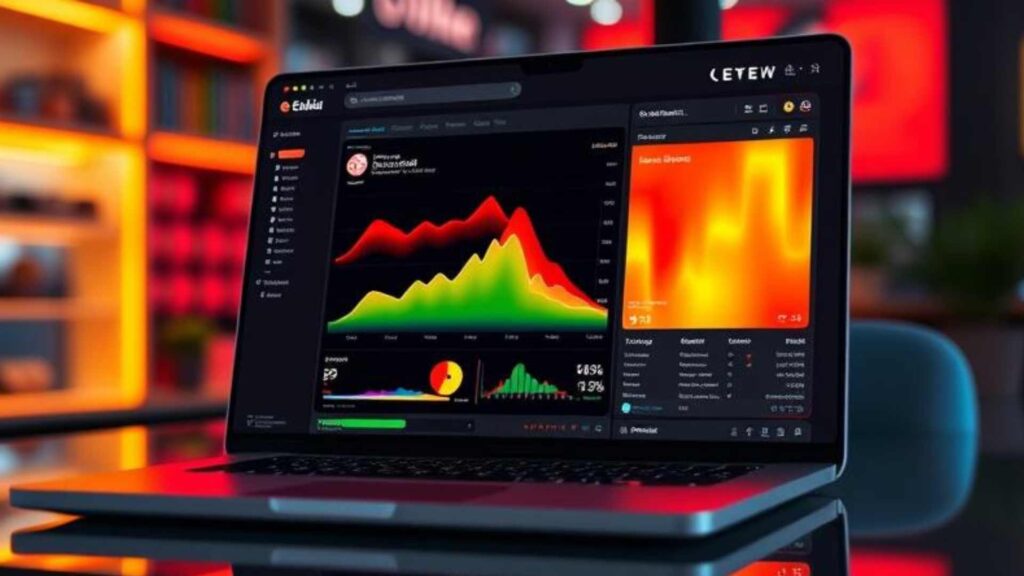Living in the world of competition, the digital environment in particular, knowledge of customer behavior on your e-commerce site is essential to success. Ecommerce heatmap tools are transformational analytics tools that enable you to get visual reports of the interaction of visitors in your online store. These are potent tools to convert raw information into colorful, easy-reading images that demonstrate what the customers are clicking, scrolling to, and what their attention is.
The use of ecommerce heatmap is very crucial in terms of conversions and the experience of the users, since they provide the hidden picture behind the behavior exhibited by the customers. Instead of presenting what occurred like traditional analytics, heatmaps provide information about where and how it occurred. They can see where there are friction points in your sales funnel, how page layouts on product pages can be optimized, and generally enhance the usability site-wide. Based on such insights, e-commerce stores can make informed business decisions that have a direct impact on performance, lower their bounce rates, and increase the satisfaction levels of their customers to achieve sustainable growth.
What is a Heatmap Tool in E-commerce?
Ecommerce heatmap tools refer to specific analytics programs that display user engagement on an online retail website in visually pictogrammatic color X-rays. These tools gather insights about how visitors engage and then can be analyzed into what is referred to as an easily readable visual representation, most highlighting patterns and trends in customer behavior.
Heatmaps are of three main types that help in ecommerce success. Click maps depict the most frequent clicks of users, where points of attraction are buttons, links, and other elements. Scroll maps are also used to show the depth of how far people scroll down the pages of websites, thus aiding in the optimization of the content and the length of the page. Movement maps show the movement of the mouse cursor, which gives information on the attention distribution of a user and the reading process.
These tools are applied in observation by inserting tracking codes into e-commerce websites, where the software can track the interaction of the user online. Data obtained is analysed and converted into graphical interpretations in which red colour indicates high-activity positions, yellow colour shows moderate zone, and blue colour shows low-interaction areas. Such visual representation provides store owners with a way to spot incredibly easy optimization opportunity.
Top Benefits of Using Heatmap Tools for E-commerce
- Better Conversion Rate Optimization: Ecommerce heatmap tools can show precisely why potential customers are leaving the purchasing process, and it is possible then to optimize the checkout process, product pages, and call-to-action buttons to have more transacting conversions.
- Better Design of User Experience: Visible information aids the detection of incoherent navigation, misplaced buttons, and content that induces no response from the visitor, and which can be optimized by rearrangement to ensure a better customer experience.
- Data-Driven Decision Making: It is often hard to make an idea of what can be efficient and effective, but with the help of a heatmap, user behavioural trends are evident and are able to be used to make informed decisions concerning layout alterations, content arrangement, and feature prioritisation.
- Minimized Cart Abandonment: Businesses can analyze heatmaps of the checkout pages to determine the friction sources that may work out the entry of customers before they can place their order, hence strategically revising processes that recoup the sales.
- Mobile Optimization insights: As mobile commerce becomes increasingly popular, heatmaps can demonstrate how mobile consumers interact with your store in different ways, and can be combined to optimize responsive layouts to have higher conversion rates on mobile.
- Content Performance Analysis: The heatmaps show what product descriptions, pictures, and reviews users pay attention to, which allows for optimizing content strategy and ensuring that their most efficacious aspects are highlighted, and increasing engagement rates.
Must-Have Features in Ecommerce Heatmap Software
- Real-Time Data Collection: This feature is absolutely necessary to track the behavior of your users in real time and make real-time adjustments in case of a critical shopping event or sale, or when you change some aspect of your e-commerce site.
- Mobile and Desktop capability: The tools of ecommerce heatmaps should be ready to follow the route on all devices, as contemporary customers use their smartphones as projected devices and have detailed data on how your customers shop on cross-device screens.
- Segmentation Capabilities: High-level filtering to identify segments of customers, traffic sources, geographical location, or different types of devices, to develop specific optimisation strategies, and to target different segments of the audience.
- E-commerce Platform Integration: It will integrate well with most of the common e-commerce platforms (Shopify, WooCommerce, Magento, BigCommerce) with seamless integration that guarantees the ease of incorporation without technical difficulties and performance problems.
- Session Recording Features: In addition to the heat maps, a recording of the actual user session gives more insight into the overall behavior of customers and what is behind the clicks, scrolls, and interactions.
- Conversion Funnel Analysis: Tracking specifically used on ecommerce funnels such as product browsers, cart additions, checkout process, and sales conversion rates to define the specific areas of optimization as the shopping funnel progresses.
Top 10 Ecommerce Heatmap Tools (Free & Paid)
1. Hotjar
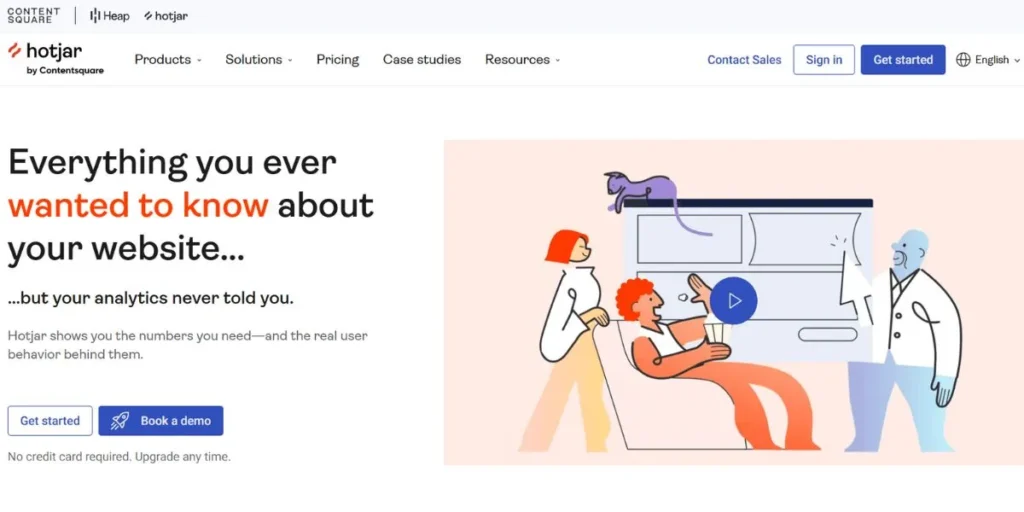
In the line of top ecommerce heatmap tools, Hotjar is one of the most popular solutions, providing detailed behavior analytics of online stores. It is an all-in-one feedback, heatmap, and session recording system that is easy to use. Hotjar is best at actionable feedback given to e-commerce companies that want to know about customer behavior patterns and make their conversion funnel better.
The user-friendly dashboard of the platform will help store owners detect problem areas and monitor the degree of improvement over a period of time. Hotjar boasts more than one million websites using it around the world, which is an indication that it is effective in assisting businesses in getting to know the behavior of users and enhancing their performance based on details provided by Hotjar.
Key Features:
- Heat maps, click-move, and scroll maps
- User journey mapping of session recordings
- Funnel conversion analysis
- Tracking of form analytics and abandonment
- Questionnaires and opinion polls
- Real-time tracking of visitors
Pros: Simple to install, free version, excellent customer service, user-friendly capacity to review heatmaps on mobile devices
Cons: Less customization, they may slow down the loading of a web page
E-commerce Integrations: Shopify, WooCommerce, Magento, and BigCommerce
Pricing: Free plan, paid starting at $32 a month
2. Microsoft Clarity
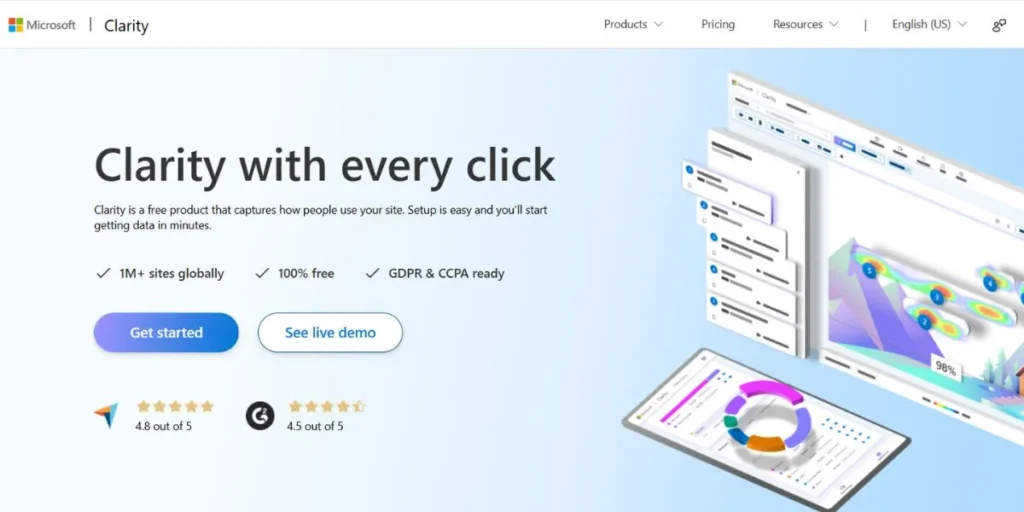
Microsoft Clarity also provides fully free ecommerce heatmap solutions with enterprise features, which is appealing to those online stores that may not have big budgets. It is a powerful platform with unlimited heatmaps and session recordings, and no data or usage limit. The AI-based insight of clarity aids in finding the point of frustration and optimization in users automatically based on the highly advanced machine learning models.
The privacy-first design of the tool offers data protection compliance with the regulations, and the tool provides strong analytics that support ecommerce shops of any scale. With the support of the well-established infrastructure of Microsoft, this platform has been used to conduct immense traffic with flair and reliability to expand businesses.
Key Features:
- Uncapped heatmaps and recordings
- Discovery and anomaly detection, with the help of AI
- Click and Scroll Terakhir
- Rage click and dead click detection
- Analytics of mobile apps
- Handling of information by the GDPR
Pros: Free, unlimited amount of data, AI analysis, high loading speed
Cons: Little customisation, less established platform with fewer features
E-commerce Integrations: Universal JavaScript, Google Tag Manager
Pricing: No fee at all
3. Crazy Egg
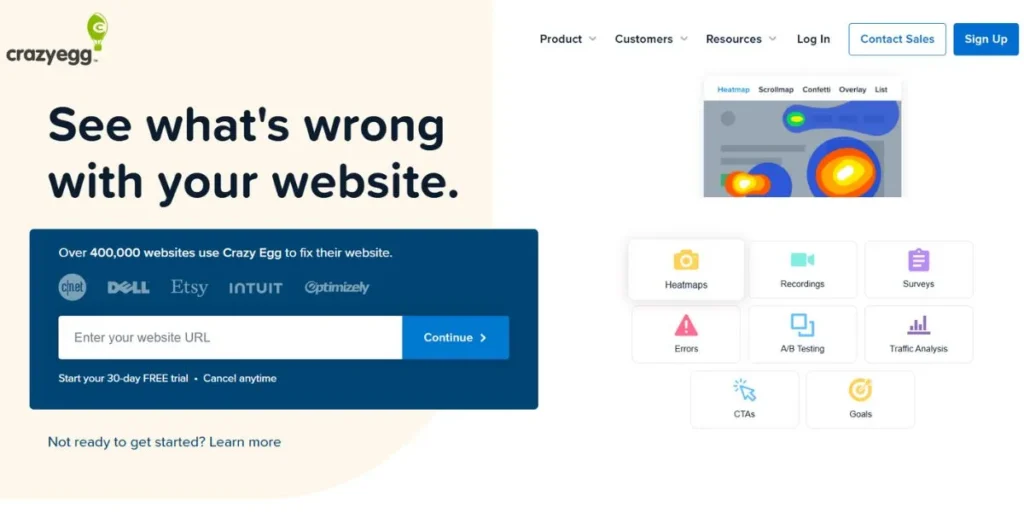
Crazy Egg invented the heatmap business and has been considered as one of the best ecommerce heatmap tools when it comes to detailed click tracking and a full map of user and browser behavior of an online retailer. The site offers clear, actionable data in both the famous click heatmaps and thorough scroll reports. The A/B testing feature built into Crazy Egg is especially useful when it comes to e-commerce sites that would like to test out various layouts and gauge their immediate effect on the level of conversions and other user engagement indicators.
Their services have been made available to over three hundred thousand websites all over the world. This has enabled the platform to keep on perfecting its features to concentrate on what makes a site get results that are measurable and an increase in revenue.
Key Features:
- With detailed click-tracking, there are click heatmaps
- Page Engagement scroll maps
- Features of A/B testing
- Link analysis overlay reports
- Confetti gives traffic sources analysis
- Heatmaps that are mobile-responsive
Pros: The first in the industry of heatmaps, great click tracking, and embedded A/B testing
Cons: Is pricey and has more features, yet too few recording sessions
E-commerce Integrations: Shopify, WordPress, custom Integrations
Pricing: The plans begin at $24/month
4. Smartlook
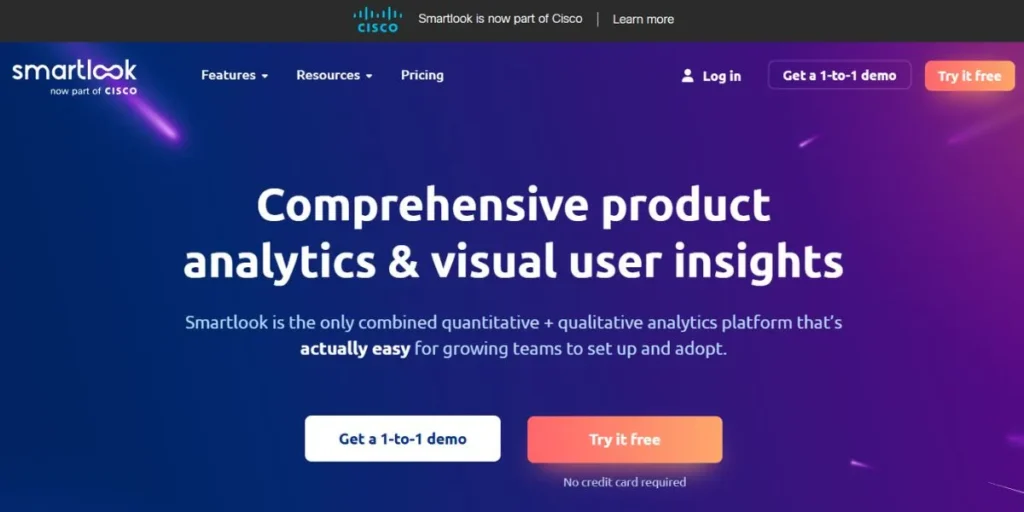
Smartlook offers a full package of ecommerce heatmap tools with powerful session recording abilities that are tailored in particular to online businesses and mobile apps. It is an advanced platform that is particularly outstanding in monitoring customer journeys throughout the conclusion of purchasing journey across various points.
The event tracking feature is advanced in Smartlook as it enables e-commerce companies to track particular actions such as add to cart clicks, checkout purchases, and more detailed product page events. Complete funnel analysis in the system helps determine exactly which point of the purchase a consumer abandons the whole process. Using its filtering abilities and powerful mobile app support, Smartlook works in both web and mobile commerce companies.
Key Features:
- Capturing of the customer journey mapping sessions
- Event-based and analytics heatmaps
- The analysis of conversion funnels: Conversion funnel analysis
- Web and App tracking
- API Custom integrations availability
- High-level filtering and segmentation
Pros: Session recording in detail, support of mobile application, and tracking the events
Cons: There is a steeper learning rate; many businesses face higher price points
E-commerce Integrations: Shopify, WooCommerce, SDKs in the cell phone applications
Pricing: Free plan is available, the paid plans are $39/month
5. Lucky Orange
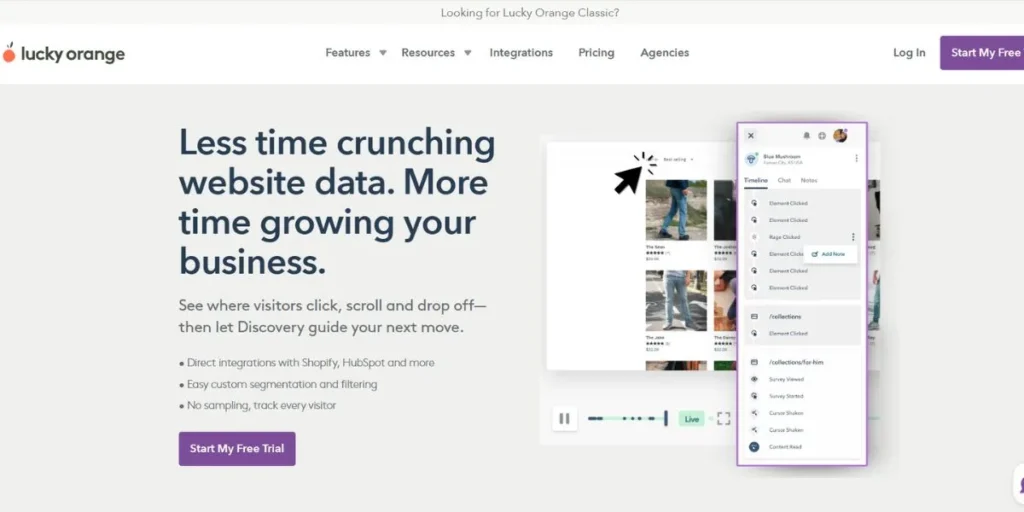
Lucky Orange is a fusion of the best price ecommerce heatmap and profit-enhancing features, integrated with live chat features that offer an intelligent, complete package solution to web retailers that desire to monitor customer behavior and communicate with visitors at the same time. This new platform has the ability to give live tracking of visitors so the store owners can view their customer sessions in real-time.
The advanced form analytics feature on Lucky Orange can also be of great benefit in streamlining the checkout process and drastically lowering the cart abandonment conversion levels within an e-commerce shop. Dynamic heatmaps allow the platform to segregate visitors along multiple dimensions such as source of traffic, type of device, and geographic location, and this enables them to come out with highly specific insights on different customer segments and demographics.
Key Features:
- Online visitor tracking
- Addition of live chat
- Completion of tracking and Analytics
- Segment-based dynamic heatmaps
- Funnels tracking
- Poll and survey instruments
Pros: The ability to integrate live chat, real-time monitoring, full free trial
Cons: The interface is a bit distracting and not fully mobile-friendly
E-commerce Integrations: Shopify, WooCommerce, BigCommerce, Magento
Pricing: The plans begin at $32/month
6. FullStory
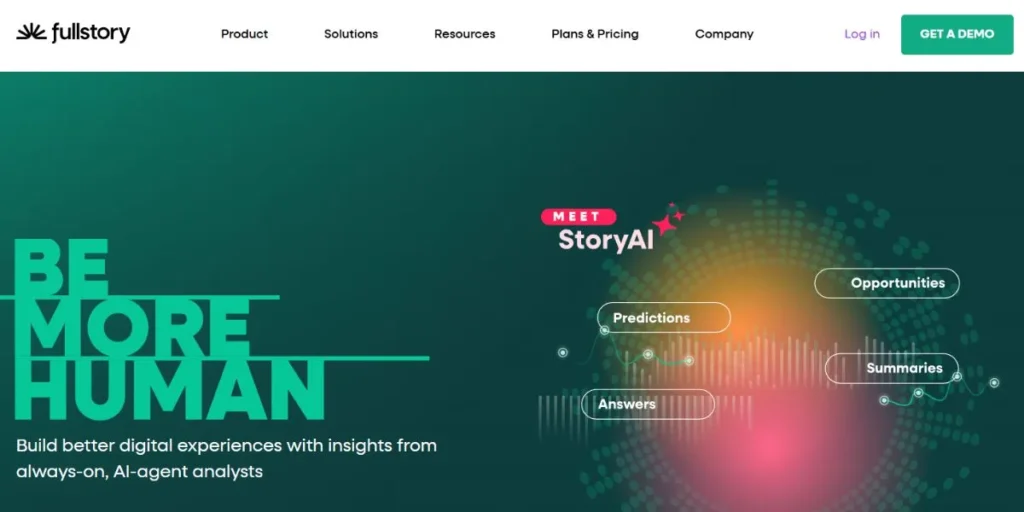
FullStory has enterprise-level heatmap tools that have more advanced search and complete analytics tools tailored towards the big retail selling online businesses. This is a robust platform that records all customer interactions and offers advanced search capabilities to identify individual user behaviours or technical problems within the shortest period. The automatic error detection system of FullStory assists in identifying technical issues that influence user experience so they can resolve them before they affect their conversions.
The high privacy settings on the platform and data masking functionalities would qualify it as a platform with significant privacy and compliance requirements, and data protection requirements among businesses. Their omnichannel capability enables teams to search by highly specific sets of criteria, and revenue impact analysis keeps the interrelation between user experience gains and realizable business results.
Key Features:
- Entire session capture and search
- Auto clash and frustration detection
- High-order matching and sorting
- Income change analysis
- Data masking and privacy control
- Custom and API accessibility
Pros: Very strong search, full-featured data capture, enterprise-level capability
Cons: A Lot of cost, technically installed, skill required to use
E-commerce Integrations: enterprise ecommerce, and custom integrations ecommerce
Pricing: Custom pricing, typically $199+/month
7. Mouseflow
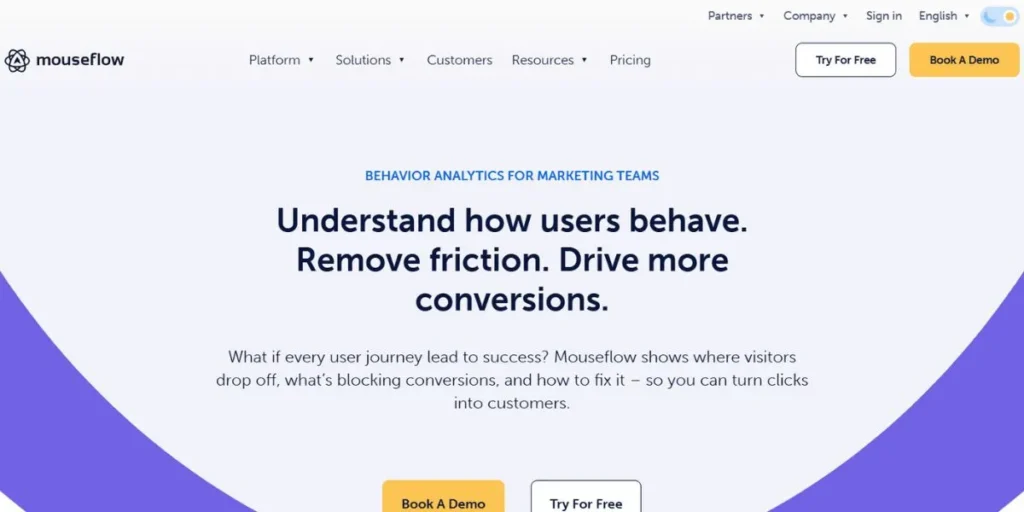
Dedicated ecommerce heatmap tools where form analytics and overall site optimization of online stores are heavily emphasized are available with Mouseflow. This platform will provide comprehensive information about customer behavior with regard to navigation features, search facilities, checkout forms, and product filters. The friction score in Mouseflow will automatically flag the page that has the highest level of user frustration so that these pages can be optimized first. Feedback campaigns on the platform give the customers an opportunity to share their ideas directly about the site development and user experience.
Their attention heatmaps will reveal exactly where the users are concentrating the most, and click rage mapping will highlight the bad things in an interface. The site recordings that are taken with Mouseflow can record the full user session, and their funnel analysis is able to show their analysis down to the very point where customers leave the purchasing process.
Key Features:
- Form analytics at the field level
- Page optimization scores Friction scores
- Feedback campaigns for websites
- Conversion tracking funnels
- Handheld and computer heatmaps
- Collaboration characteristics of a team
Pros: high-grade form analytics, detection of friction, low cost
Cons: Lack of a large number of recordings available on the sessions; basic tools to define the segmentation
E-commerce Integrations: Shopify, Woo, Magento, HTML custom-made
Pricing: No charge, paid options start at $31/month
8. Plerdy
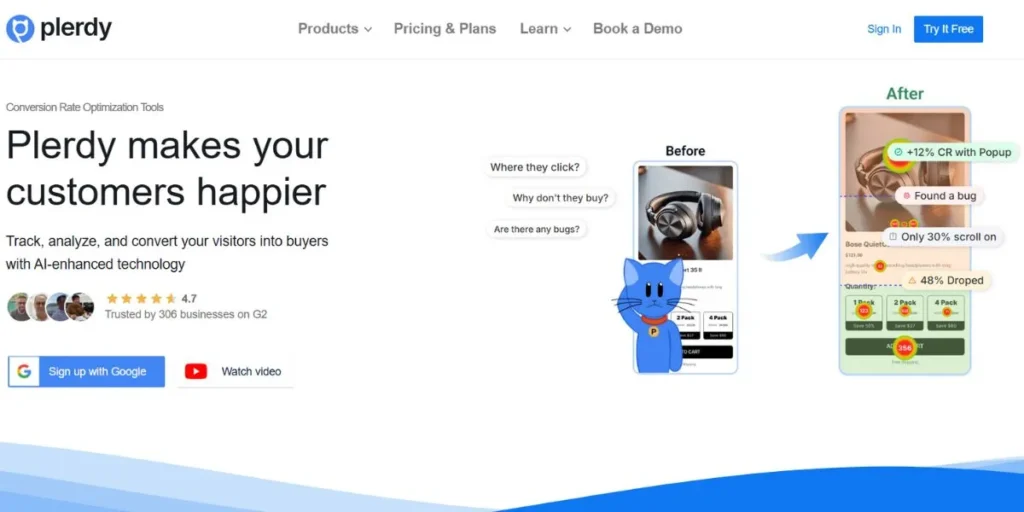
Plerdy focuses on e-business heatmap with an in-built SEO and conversion optimization tool that has been designed in such a way that the tool guarantees the online retailer and the online marketer. In one whole package, this platform brings together heatmaps and pop-ups, A/B experiments, and in-depth SEO-related analysis features. The features of Plerdy that are custom-made regarding e-commerce are the suggestions on the optimization of the product page and the initiatives aimed at studying the shopping behavior thoroughly.
White-label facilities of the platform make it especially eye-catching to those using the platform to offer services to several e-commerce clients at a time. Their heat maps technology is specifically aimed at sales funnel optimization, and the built-in popup builder is aimed at the acquisition of leads and minimizing cart abandonment rate. The checker tool in plerdy seo examines the performance of the pages and gives suggestions by ranking rules and optimization of the user experience.
Key Features:
- E-commerce-specific metrics on heat maps
- Incorporated pop-up and A/B testing software
- SEO report and suggestions
- Optimization tips on product pages
- White-label agency services
- Having multiple domains tracking ability
Pros: Capabilities of being feature-oriented (ecommerce-focused), optimization built in, white-label-able
Cons: New platform, few reviews, fewer people using it
E-commerce Integrations: Shopify, WooCommerce, OpenCart, PrestaShop
Pricing: paid options start at $39/month
9. VWO Insights
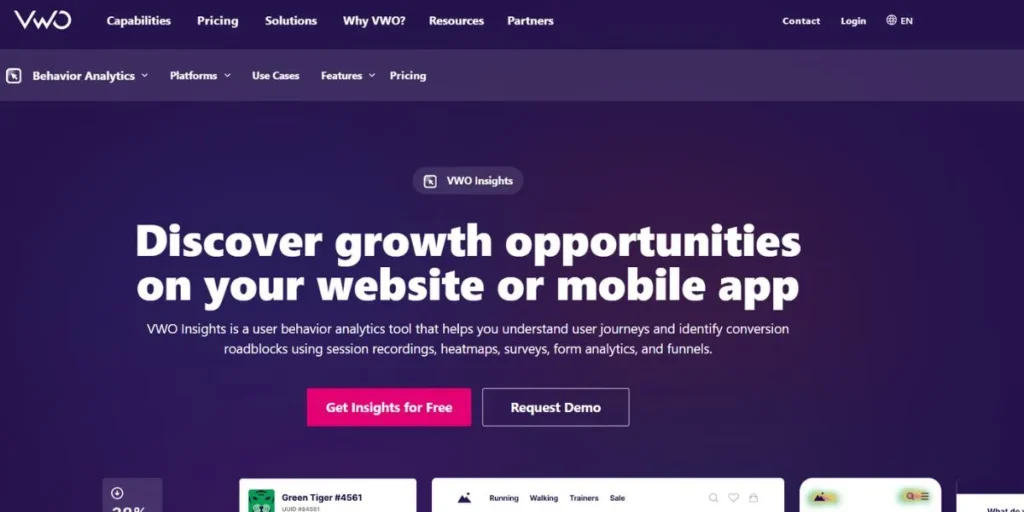
VWO Insights provides ecommerce heatmap software to businesses at an enterprise level, as it is a platform of conversion optimization tools aimed at serious online retailers. This state-of-the-art answer offers a thorough analysis of behavior, which is complemented by advanced testing, as well as analysis of the statistics. The SmartStats engine employed by VWO applies Bayesian statistics, which delivers reliable results of tests within a shorter time as compared to the statistical approach.
A full optimization ecosystem exists with other VWO products that have been natively integrated into the platform, making it a whole ecosystem available to serious businesses concerning e-commerce. The recordings in their sessions involve sophisticated filters, and the behavior analysis tools detect micro-conversions and elaborate patterns in the engagement of the user. VWO revenue attribution modeling helps to tie the conversion uplifts, achieved through UX enhancements, to quantifiable business results, enabling a business to justify the ROI costs of optimization and referencing it and or estimating it.
Key Features:
- Statistical significance in advanced heatmaps
- Behavior tagging Session recordings
- Form stats and optimization
- Multi-device tracking
- Revenue attribution model
- Highly advanced features of segmentation
Pros: Company functionality, statistical strength, the ability to integrate features of the entire platform
Cons: More expensive, a set of optimization skills is needed, complicated interface
E-commerce Integrations: Shopify Plus, Magento Enterprise, built-in e-commerce integrations
Pricing: Custom pricing, typically $199+/month
10. Contentsquare
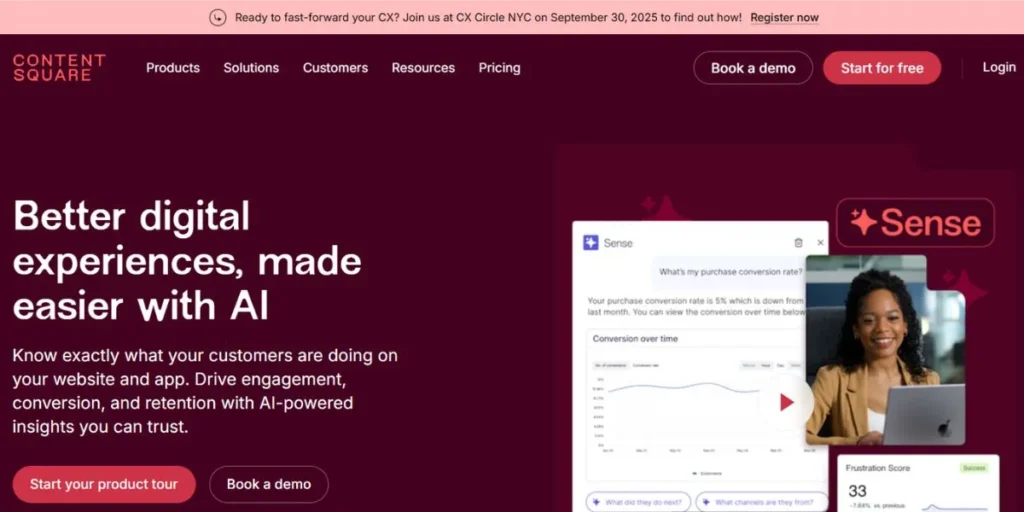
Contentsquare offers AI-enhanced ecommerce heatmaps specifically aimed at the enterprise retailer that wants greater insights into their customer behaviors and predictive capabilities. The platform is a highly advanced tool based on machine learning that picks optimization possibilities and future user behavior trends with no manual input at all. The journey analysis feature provided by Contentsquare shows entire customer paths in a series of sessions and touchpoints. The quantification of the impact of platforms reveals precisely how revenue and major business metrics will be influenced by the improvement of UX.
They offer insights that can be trusted to be contextual, as their analysis is formed on the zone-level, and the AI algorithms learn every single time the user engages them. The sophisticated attribution modeling used by Contentsquare allows bridging the gap between micro-level user interactions and macro-business-driven results, enabling enterprise teams to prioritize optimization initiatives according to their future revenue-earning potential and their ability to improve customer satisfaction.
Key Features:
- Machine learning behavior analysis
- Session-to-session journey mapping
- Optimization of impacts
- Business context zone-based heatmap
- Behavior tracking of the mobile apps
- Advanced attribution model
Pros: Artificial intelligence-driven intelligence, scalability of the business, comparative analytics
Cons: It is very, very costly, hard to achieve, and requires special resources
E-commerce Integrations: Custom enterprise e-commerce implementations
Pricing: Custom enterprise prices
Comparison Table: Best Heatmap Tools at a Glance
| Tool | Starting Price | Best For | Key Integration | Standout Feature |
| Hotjar | $32/month | Small-medium stores | Shopify, WooCommerce | User-friendly interface |
| Microsoft Clarity | Free | Budget-conscious retailers | Universal JavaScript | Unlimited free usage |
| Crazy Egg | $24/month | Click tracking focus | Shopify, WordPress | Pioneer heatmap technology |
| Smartlook | $39/month | Complete journey tracking | Mobile apps, Shopify | Event-based analytics |
| Lucky Orange | $32/month | Real-time monitoring | Live chat integration | Real-time visitor watching |
| FullStory | $199+/month | Enterprise retailers | Custom implementations | Complete session capture |
| Mouseflow | $31/month | Form optimization | Form analytics focus | Friction score detection |
| Plerdy | $39/month | SEO + heatmaps | Multi-platform support | Built-in optimization tools |
| VWO Insights | $199+/month | A/B testing integration | Enterprise platforms | Statistical significance |
| Contentsquare | Enterprise | Large-scale operations | AI-powered insights | Machine learning analysis |
How to Use Heatmaps to Optimize Your E-commerce Store
- Analyze Product Page Performance: Examine product pages’ click heatmaps in order to see which imagery, product descriptions, and buttons people pay the most attention to. Maximize the effectiveness of product galleries and call-to-action locations using e-commerce heatmap software to expose user interaction patterns.
- Optimize Checkout Process: Monitor the clicks and form analytics by tracking areas of friction in the checkout process. Improve button manifestation and facilitate simplification of forms and the purchasing process on the basis of the heatmaps information to decrease rates of cart abandonment.
- Improve Navigation Hierarchy: Do an A/B test and compare the items in the main navigation menu and the category clicks. Heatmap tools on ecommerce sites bring to light what menu items are not being looked at and what are getting more attention than they should, so that navigation can be restructured to have a better user pathway.
- Optimize Mobile UX: Contrast mobile and desktop heatmaps to get an idea of device-specific differences in behavior. The conversion rates can be improved depending on the mobile user interaction pattern by optimizing button sizes and placement of the content and the scrolling factor.
- Test Content Placement: Scroll maps can be used to find the best place to put important information such as reviews, specifications, or trust badges. Put vital conversion elements in the top engagement areas, in which a heatmap is used to calculate them.
- Determine Distraction Elements: Find the elements that can get clicks but which do not play a conversion role. Eliminate or move distracting elements that draw the attention of users away from the major conversion objectives that are indicated through analysis using heat maps.
Free vs Paid Heatmap Tools: Which One to Choose?
Free Tools Benefits
- No-Cost Entry Point: Free ecommerce heatmap solutions, such as Microsoft Clarity, are a good option as an entry point due to the absence of a financial requirement to sample, but outstanding results are available at no financial risk.
- Basic Feature Coverage: Almost all free tools provide the basic features that heatmaps can offer, such as click mapping, scroll tracking, and session recording, which serve as enough knowledge about the improvement necessities of small ecommerce businesses with simple optimization requirements and low amounts of traffic.
- Risk-Free Testing: Free editions enable companies to test the effectiveness of heat maps and learn more about user behavior patterns to see the necessity of investing in premium solutions first, which will help companies see whether the additional functions are worth spending extra money on the specific business needs.
Paid Tools Advantages
- Advanced Analytics Functionality: Highest-level ecommerce heatmap tools have powerful features such as funnel analysis, revenue mapping, complex segmentation, and A/B testing integration that can be used to gain even greater insights on serious conversion optimization projects and optimization-driven business development.
- Priority Customer Support: The paid plans usually feature specialized customer assistance, shorter response rates, and an in-depth onboarding process, which allows users to introduce paid plans painlessly and extract as much value as possible out of heatmap data to make solid business decision-making processes.
- Scalability and Integration: Tools that are used at an enterprise level will allow high traffic and are often rich in third-party integrations and sophisticated customization options that more complex and emerging ecommerce businesses may need on the analytics and tuning front.
Limitations of Heatmaps & Common Mistakes to Avoid
- Privacy and Compliance: The use of ecommerce heatmap tools should not be punitive since they are GDPR privacy compliant, CCPA privacy compliant, and privacy regulation compliant. Improperly setting up privacy parameters or lacking the above-mentioned user consent may lead to legal issues and hurt their trust toward a customer.
- Over-Reliance on Visual Data: Heatmaps can demonstrate where the users click, and not the reason behind the particular user behavior. On top of using heatmap data, a user survey, customer feedback, and qualitative research can help give a more in-depth view before deciding to optimize.
- Misinterpretation of Sample Size: The improper size of data when used in making optimization decisions may give rise to wrong conclusions. Be sure to have an optimum volume of traffic and statistical significance when applying the factors of analysis of a heatmap and the behavior of users to make changes.
- Mobile and Desktop Confusion: The analysis conducted by mobile and desktop platforms might give an ambiguous assessment. Ecommerce heatmaps should be set to segment the type of devices to have correct optimization strategies adapted to the considered user experiences and behaviors.
- Lack of Context and Intent: Heatmaps Balance: while they give an insight into the behavior patterns, they do not tell anything about user motivation and outside factors behind actions. Heatmap data should be interpreted or used together with seasonal trends, marketing campaigns, and user demographics to sensibly optimize them.
- Technical Execution Mistakes: The wrong placement of tracking codes, the absence of page settings, or the wrong way of filtering may lead to false data gathering. Proper auditing means that ecommerce heatmap tools collect credible information that can be used in the business decision-making processes.
Conclusion
Online retailers are finding it hard to do without ecommerce heatmap tools as they attempt to improve the conversion rate of their websites by tracking the behavior of customers. Such powerful analytics solutions offer visual guidance that turns abstract data into applicable optimisation tactics. Depending on which category of users you are: those who would prefer to work with free tools, such as Microsoft Clarity, or those who would like to choose a more enterprise-level solution, such as Contentsquare, the trick is to know which tool suits your business and traffic more.
In this competitive age of online purchasing, purchasing stores are trying to maximize their conversion rate and enhance their revenue growth by taking advantage of having a heatmap understanding to optimize and streamline the product pages, decrease the checkout procedures, and develop a better user experience.
FAQs
What are ecommerce heatmap tools?
Ecommerce heatmap tools are a type of analytics software used to visualize user activity on the online store using color overlay and present the location of mouse clicks, scrolls, and areas of interest where optimization can be made.
What is the way heatmaps enhance conversion?
The heatmaps help to discover the areas where customers face some friction in their experience; these maps help to see which points are captivating customers and which ones make them leave the buying process, which allows making adjustments to improve it.
Are free heatmap tools sufficient for small stores?
Yes, some tools are free and permit the critical heatmap feature, such as Microsoft Clarity, which is the option to be used in smaller ecommerce stores where optimization requirements are not extensive and traffic levels are not high.
Which heatmap tool is best for mobile optimization?
Hotjar and Smartlook can be used to track a mobile heatmap, which can be essential in understanding the areas of focus that need improvement when it comes to conversions and mobile commerce performance.
How long should I collect heatmap data before making changes?
Proper insights can be obtained within 2-4 weeks or until a statistical significance (usually with 1,000+ visitors) is obtained, so one can be sure that optimization changes can be performed on the basis of the patterns.

